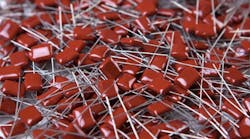With the New Year beginning to come into sight, the passive and interconnect market is seeing much of the same that it has for most of the year: lower prices, shorter lead times, and good availability across most product types. Made up of electronic components that don’t require electrical power or any other source of energy to operate (passives) and those that are used to interconnect multiple components into integrated assemblies (interconnecting), the market is expected to continue on this path through the fourth quarter and into 2016.
In his most recent state of the industry report on passive electronic components, Dennis M. Zogbi of Paumanok Publications, Inc., said the global passive electronic component industry accounted for approximately $26 billion in global revenues for 2015 (fiscal year ending March 2015), with almost 3.5 trillion pieces shipped.
Lead times for capacitors at the time were well below their usual run rates, according to Zogbi, “with lead times for all dielectrics showing no change month-to-month and some additional weakness in specific sub-sets of both the electrostatic and electrolytic segments.”
Zogbi noted a “significant decrease” in the Passive Component Raw Material Index during the fall of 2015—most likely due to the overall drop in the world’s commodity prices.
“While the lower raw materials pricing bodes well for profitability for passive component manufacturers,” Zogbi writes, “it is also a testament to a weak global economy.”
Breaking Down the Market
In Passive and Interconnecting Electronic Components Market-Global Segments and Forecast up to 2023, Transparency Market Research notes that with demand for combined modules such as multichip and system-on-a-chip growing, the need for passive and interconnecting electronic components is expected to increase. Growth in the market is characterized by innovations and development of advanced technologies in the electronic industry, the firm reports.
“With increasing demand for consumer electronics products such as digital cameras, portable music players, gaming consoles, and laptops, the passive and interconnecting electronic components market is expected to witness good growth,” the firm states in its research report, which includes AB Connectors, American Electronic Components, API Electronics, AVX, Cisco Systems, Delphi Connection Systems, EDAC, Fujitsu, Panasonic, and Philips Electronics (among others) on its list of key players in this market segment.
Geographically, Asia Pacific is the largest passive and interconnecting electronic components market and is “expected to continue its dominance owing to surging demand from verticals like telecom, consumer electronics, healthcare, and information technology,” according to the report. “Transition from existing standards to higher communication standards such as 4G LTE and 5G is expected to have a positive impact on the growth of the market. In addition, increasing penetration of Internet services in China, India, and other developing economies is expected to fuel demand for electronic devices and components.”
A Sluggish Year
In assessing current market conditions for passives and interconnecting components, Jeff Ray, vice president of corporate product supply marketing for TTI, Inc., in Fort Worth, Texas, says 2015 has been a “sluggish year” that has produced low single-digit growth over 2014 in most vertical markets in the Americas. “The outliers to this have been transportation, which has grown significantly faster than the overall market and down hole/oil & gas, which has had its challenges,” he says.
Specifically during the third quarter of 2015, Rays says end-customer bookings have been consistent with the second quarter of the year, while lead times and pricing started to firm up.
“I would project that the fourth quarter will mirror the third quarter,” says Ray.
Looking ahead, Ray said he expects 2016 to provide some upside within this segment of the electronics market as investments in capital equipment increase.
“However, overall growth will still only be in the mid- to low-single digit ranges,” says Ray. “Overall inventory pipelines have been adjusted in 2015 to meet current demand, so lead times and pricing will continue to stabilize in 2016 with potential increases in the second quarter of next year.”








